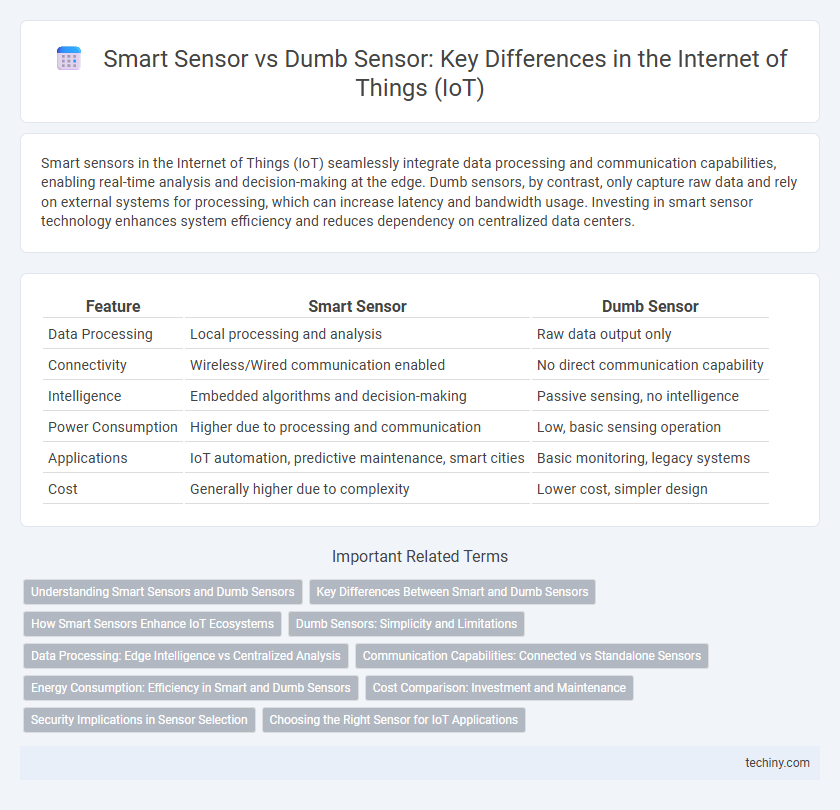Smart sensors in the Internet of Things (IoT) seamlessly integrate data processing and communication capabilities, enabling real-time analysis and decision-making at the edge. Dumb sensors, by contrast, only capture raw data and rely on external systems for processing, which can increase latency and bandwidth usage. Investing in smart sensor technology enhances system efficiency and reduces dependency on centralized data centers.
Table of Comparison
| Feature | Smart Sensor | Dumb Sensor |
|---|---|---|
| Data Processing | Local processing and analysis | Raw data output only |
| Connectivity | Wireless/Wired communication enabled | No direct communication capability |
| Intelligence | Embedded algorithms and decision-making | Passive sensing, no intelligence |
| Power Consumption | Higher due to processing and communication | Low, basic sensing operation |
| Applications | IoT automation, predictive maintenance, smart cities | Basic monitoring, legacy systems |
| Cost | Generally higher due to complexity | Lower cost, simpler design |
Understanding Smart Sensors and Dumb Sensors
Smart sensors integrate processing capabilities, enabling real-time data analysis and decision-making at the source, which enhances efficiency and reduces latency in Internet of Things (IoT) applications. Dumb sensors, in contrast, simply collect and transmit raw data without local processing, relying on external systems for analysis and interpretation. Understanding the distinction between smart and dumb sensors is critical for optimizing IoT networks, as smart sensors improve scalability, responsiveness, and energy efficiency compared to their dumb counterparts.
Key Differences Between Smart and Dumb Sensors
Smart sensors integrate microprocessors that enable data processing, self-calibration, and adaptive responses, while dumb sensors solely collect raw data without any processing capability. Smart sensors offer enhanced accuracy, real-time analytics, and communication abilities via IoT networks, contrasted with dumb sensors that require external systems for data interpretation. The key differences lie in intelligence, connectivity, and autonomy, which make smart sensors essential for advanced IoT applications.
How Smart Sensors Enhance IoT Ecosystems
Smart sensors enhance IoT ecosystems by integrating data processing capabilities directly within the sensor, enabling real-time analysis and decision-making at the edge. These sensors reduce latency and bandwidth usage by filtering and interpreting data before transmission, improving overall system efficiency and responsiveness. Incorporating features like self-calibration and adaptive learning, smart sensors significantly boost the accuracy and reliability of IoT applications across diverse industries.
Dumb Sensors: Simplicity and Limitations
Dumb sensors operate with basic data collection capabilities, lacking onboard processing or decision-making functions, which ensures simplicity and lower power consumption. Their limited functionality restricts real-time data analysis, making them dependent on external systems for interpretation and intelligence. This fundamental simplicity can hinder scalability and adaptability in complex Internet of Things (IoT) environments where rapid, autonomous responses are crucial.
Data Processing: Edge Intelligence vs Centralized Analysis
Smart sensors integrate edge intelligence, enabling real-time data processing and decision-making directly at the source, which reduces latency and conserves bandwidth. Dumb sensors solely gather raw data, relying on centralized analysis systems to process information, often causing delays and increasing network congestion. The shift towards edge intelligence in smart sensors optimizes the Internet of Things architecture for faster, more efficient, and scalable data handling.
Communication Capabilities: Connected vs Standalone Sensors
Smart sensors feature built-in processing and communication capabilities, enabling real-time data transmission and integration within IoT networks. Dumb sensors operate as standalone devices that collect raw data without internal processing or connectivity, requiring external systems for data analysis. The communication capabilities of smart sensors facilitate enhanced automation, remote monitoring, and seamless interoperability across connected devices.
Energy Consumption: Efficiency in Smart and Dumb Sensors
Smart sensors typically consume less energy than dumb sensors due to their ability to process data locally and transmit only relevant information, reducing communication overhead. Dumb sensors require constant transmission of raw data for external processing, resulting in higher energy consumption. Energy efficiency in smart sensors extends battery life and supports sustainable IoT deployments by minimizing power usage in edge devices.
Cost Comparison: Investment and Maintenance
Smart sensors have higher upfront investment costs due to embedded processing capabilities and advanced communication modules, while dumb sensors are generally low-cost with minimal initial expenditure. Maintenance expenses for smart sensors tend to be lower over time because of self-diagnostic features and remote update capabilities, reducing manual intervention. In contrast, dumb sensors often incur higher long-term maintenance costs due to frequent replacements and lack of real-time monitoring.
Security Implications in Sensor Selection
Smart sensors equipped with onboard processing and communication capabilities offer enhanced security features such as encryption, authentication, and anomaly detection, reducing the risk of cyberattacks in Internet of Things (IoT) environments. Dumb sensors, lacking intelligent processing and security protocols, are more vulnerable to data breaches and unauthorized access, exposing IoT networks to potential threats. Selecting smart sensors is crucial for maintaining robust security frameworks in IoT deployments, enabling secure data transmission and real-time threat mitigation.
Choosing the Right Sensor for IoT Applications
Smart sensors integrate data processing capabilities and connectivity features, enabling real-time monitoring and autonomous decision-making in IoT applications. Dumb sensors, while simpler and cost-effective, only collect raw data that require external processing units, potentially increasing latency and system complexity. Selecting the right sensor depends on factors like application complexity, power consumption, budget, and the need for data pre-processing or edge computing in IoT systems.
Smart Sensor vs Dumb Sensor Infographic

 techiny.com
techiny.com